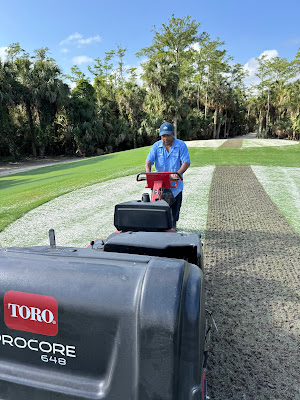As many people do, I use the holiday season as a time to slow down and reflect on life and the experiences that shaped the past year. It’s a natural pause point and a moment to look back before stepping forward again.
As an avid amateur photographer, and someone deeply passionate about both Olde Florida Golf Club and the profession I’ve devoted my career to, I find myself constantly behind the lens capturing the things I am fortunate to witness. Much of my photography is work-related, and caught during early mornings and long days on the golf course. Within the moments are stories, scenes, and details that resonate far beyond the task at hand.
Since 2022, I’ve made it a tradition at the end of each year to review every photograph I’ve taken, this year, more than 3,000 images. From that collection of memories, I select the photographs that carry extra meaning: images that capture not just what I saw, but how it felt to be there in that moment.
What follows is my 2025 Year in Review Through Photographs, a visual reflection of the year as I experienced it, one image at a time.
 |
Each year, I select one photograph to feature on my Christmas card. This image, taken on March 20 on the third green at Olde Florida Golf Club, was the photo I chose for my 2025 card. |
 |
 |
An early morning view of the practice green at Olde Florida Golf Club. Quiet, calm, and full of promise. Taken on February 1. |
 |
Few things beat the smell of freshly cut grass. The TifTuf on the 12th fairway at Olde Florida Golf Club looked especially beautiful on Valentine’s Day, February 14. |
 |
Since the 2021 renovation, the combination of TifEagle, TifGrand, and TifTuf has delivered exceptional results at Olde Florida Golf Club—and on February 18, it was truly on display. |
 |
One of our favorite annual traditions for the Member/Guest Invitational is painting the Olde Florida logo behind the championship tee on the first hole at Olde Florida Golf Club. February 19. |
 |
There is something exceptionally peaceful about watching irrigation at sunrise on the 10th hole at Olde Florida Golf Club. Photo taken on February 22. |
 |
 |
While golfers at Olde Florida Golf Club make plenty of birdies, the Screech Owls are a special kind of “birdie,” reminding us that the course is home to much more than the game itself. March 20. |
 |
Foggy mornings make life difficult for the dew sweepers and the agronomy team at Olde Florida Golf Club. The heavy fog on April 1 was no April Fool’s joke. |
 |
Another example of the phenomenal bunkering by Rees Jones, Inc. at Olde Florida Golf Club. Spring had definitely sprung on April 11. |
 |
Meet Julia Roberts—our famed Screech Owl, named after the actress who starred in Runaway Bride. Much like her namesake, glimpses of Julia are rare, as she is excellent at running away. April 14. |
 |
Sunrise is my favorite time of day. Summer cultural practices, such as vertical mowing, may not be a golfer’s favorite, but they are a necessary part of caring for the golf course. June 24. |
 |
September 15, summer cultural practices are complete and the TifEagle, TifGrand, and TifTuf at Olde Florida Golf Clubare ready for the upcoming busy winter golf season. |
 |
 |
 |
Among the many great moments throughout the day, one of my favorite late-afternoon views is on the 16th hole at Olde Florida Golf Club. |
 |
With Thanksgiving just around the corner, November 24 was a day to be thankful for great weather and TifTuf that was truly showing off at Olde Florida Golf Club. |
























